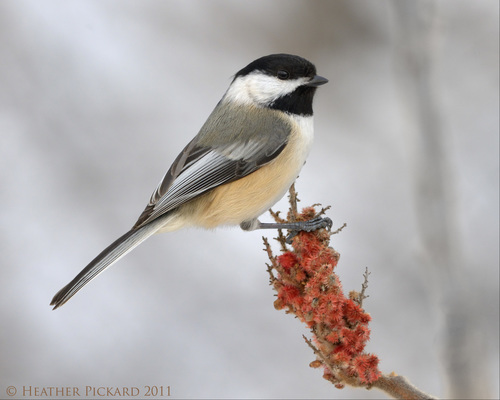
Black-capped Chickadee
The Black-capped Chickadee (Poecile atricapillus) is a small, energetic songbird widespread across North America. Known for its distinctive 'chick-a-dee-dee-dee' call, this species plays a vital role in controlling insect populations. It's also admired for its remarkable memory, allowing it to cache food in thousands of locations and retrieve it months later. Culturally, the Black-capped Chickadee is often seen as a symbol of cheerfulness and resilience in the face of harsh winter conditions.
12-15 cm
Length
16-21 cm
Wingspan
Least Concern
Conservation Status
Distribution
Found across North America, from Alaska and southern Canada to the northern half of the United States. It is generally non-migratory, though some populations may move short distances south within their range in winter.
Lifespan
Average 2-3 years in the wild; up to 10 years in captivity.
Black-capped Chickadee's Habitat
Habitat Types
Deciduous forests, Mixed forests, Open woodlands, Parks, Suburban areas with trees
Climate Zones
Temperate, Boreal
Adaptations
They are well-adapted to cold climates, possessing dense, insulating feathers and the ability to lower their body temperature at night (nocturnal hypothermia) to conserve energy.
Variations
Several subspecies are recognized, differing slightly in plumage and song, primarily based on geographic location.
Appearance
Breeding Plumage
Plumage remains similar year-round.
Seasonal Feather Changes
None
Sex Based Plumage Differences
Males and females have nearly identical plumage.
Notable Features
Black cap and bib, White cheeks, Gray back, wings, and tail, Buffy flanks
Diet and Feeding
Primary Foods
Insects, Spiders, Seeds, Berries
Foraging Behavior
Actively gleans insects and spiders from leaves and branches. Also hovers briefly to pick food from surfaces. Known for caching food items in numerous locations.
Specializations
Excellent spatial memory allows them to remember the locations of thousands of cached food items.
Seasonal Diet Variations
Diet shifts with seasonal availability. Insects and spiders are dominant in summer, while seeds and berries are more important in winter.
Behavior
Social Structure
Forms flocks during the non-breeding season, often with a dominance hierarchy. Pairs form during the breeding season.
Communication
Complex vocalizations, including the 'chick-a-dee-dee-dee' call, which conveys information about predators and flock identity., Visual displays, such as wing flicking.
Migration
Generally non-migratory, but some populations may exhibit short-distance movements in response to food availability or severe weather.
Territorial or Group Behaviors
Territorial during the breeding season, defending the area around the nest. Forms mixed-species flocks with other small birds in winter.
Conservation
Threats
Habitat loss due to deforestation and urbanization, Pesticide use affecting insect prey, Competition with invasive species (e.g., House Sparrows) for nesting cavities
Protection Programs
General habitat conservation efforts, Promotion of responsible pesticide use, Provision of nest boxes
Local National Laws
Protected under the Migratory Bird Treaty Act in the United States and similar legislation in Canada.
Population Trend
Stable
Population Estimates
Global population estimated to be around 43 million.
Interesting Facts
They can remember thousands of hiding spots for food.
This incredible spatial memory is crucial for surviving harsh winters.
Their brain grows new neurons each fall.
This neurogenesis helps them update their mental maps for caching food.
Different number of 'dee' notes indicate threat.
More 'dee' notes in their 'chick-a-dee' call indicates a higher level of threat from a predator.
Faqs about Black-capped Chickadee
What do Black-capped Chickadees eat?
They eat a mix of insects, spiders, seeds, and berries, varying their diet with the seasons.
Do Black-capped Chickadees migrate?
They are generally non-migratory, but some may move short distances in winter.
Where do Black-capped Chickadees nest?
They nest in tree cavities, old woodpecker holes, or nest boxes.
How can I attract Black-capped Chickadees to my yard?
Provide a source of fresh water, offer sunflower seeds, suet, or peanuts in feeders, and install nest boxes.
Copyright @ Nature Style Limited. All Rights Reserved.
 English
English